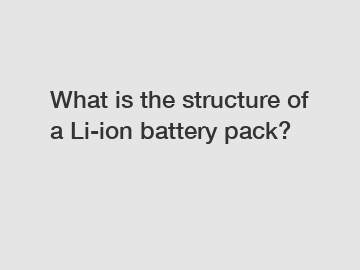What is the structure of a Li-ion battery pack?
What is the Structure of a Li-ion Battery Pack?
As electronic devices become more prevalent in our everyday lives, the demand for efficient and long-lasting batteries has skyrocketed. Lithium-ion (Li-ion) batteries have emerged as the preferred choice for portable electronic devices due to their high energy density, lightweight construction, and ability to hold a charge for extended periods. Understanding the structure of a Li-ion battery pack is essential in order to comprehend how these batteries function and power our devices.
I. Overview of Li-ion Batteries.

Li-ion batteries are rechargeable power sources that store and release energy through the movement of lithium ions between two electrodes – an anode and a cathode. The battery pack is composed of several individual cells connected in series or parallel to achieve the desired voltage and capacity.
II. Anode and Cathode.
The anode of a Li-ion battery is typically made of carbon, which allows for the reversible intercalation of lithium ions during charge and discharge cycles. This anode material enables the storage and release of energy in the battery. On the other hand, the cathode is made up of a metal oxide compound, such as lithium cobalt oxide or lithium iron phosphate. During operation, the cathode acts as the host for lithium ions, which are stored and released during the battery's charge and discharge cycles.
III. Separator.
Separating the anode and cathode is a thin, porous separator made of a polymer material. The separator prevents direct contact between the two electrodes while still enabling the passage of lithium ions. This physical separation ensures the prevention of short circuits and keeps the battery functioning safely.
IV. Electrolyte.
The electrolyte of a Li-ion battery is a conductive solution containing lithium salts, such as lithium hexafluorophosphate. This solution allows for the movement of lithium ions from the anode to the cathode during the discharge cycle and in the opposite direction during charging. The electrolyte also plays a crucial role in maintaining the overall performance of the battery by facilitating ion transport and ensuring the electrochemical reactions occur efficiently.
V. Housing and Protection.
The battery pack is enclosed within a housing, which serves as a protective case and prevents damage to the cells and internal components. The housing is typically made of plastic or metal, providing structural support for the battery pack. Moreover, the housing includes built-in safety features such as thermal sensors and protective circuits, which monitor and control the battery's temperature, voltage, and current levels. These safety mechanisms prevent overcharging, over-discharging, and overheating of the battery, reducing the risk of a potential fire or explosion.
In conclusion, the structure of a Li-ion battery pack is designed to maximize energy storage capacity, while ensuring the safety and reliability of the battery. The combination of an anode, cathode, separator, and electrolyte allows for the movement of lithium ions, storing and releasing energy during charge and discharge cycles. The housing and protective circuits ensure the safe operation of the battery, preventing any potential hazards. As technology continues to advance, the structure and design of Li-ion batteries will continue evolving to meet the increasing demands for longer-lasting, more powerful batteries.
For more information or if you have any queries, please do not hesitate to contact us.
For more information, please visit prismatic lifepo4 battery, 280ah Lifepo4 Battery, Lifepo4 280ah.
275
0
0

Comments
All Comments (0)